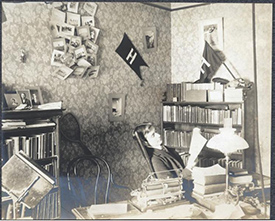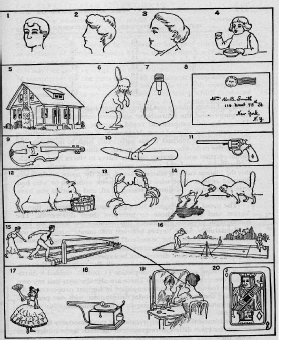
Yerkes brought together all the major hereditairans of American psychometrics to write the army mental test. From May to July 1917 he worked with … [Henry] Goddard, and other colleagues at Goddard’s Training School in Vineland, New Jersey. Their scheme included three types of tests. Literate recruits would be given a written examination, called the Army Alpha. Illiterates and men who had failed Alpha would be given a pictorial test, called the Army Beta. Failures in Beta would be recalled for an individual examination, usually some version of the Binet scales.
Following is Test 6 of the Army Beta. Take the test yourself. You will find Yerkes’ grading instructions in the knowledge processes section of the online material for this chapter, so you can see how well you went. If you don’t do very well within the three allotted minutes, you’re probably a moron.
Imagine you are in a large examination room. An examiner and demonstrator stand at the front of the room, and orderlies around the room in various places to check that nobody is cheating. Here are the instructions, following which the printed test page is presented to the men being examined.
‘This is test 6 here. Look. A Lot of Pictures … Now watch.’ Examiner points to hand [picture with one finger missing] and says to demonstrator, ‘Fix it’. Demonstrator then draws a finger. Demonstrator does nothing, but looks puzzled. Examiner points to the picture of the hand, and then the place where the finger is missing and says to the demonstrator, ‘Fix it; fix it’. Demonstrator then draws in a figure. Examiner says, ‘That’s right’ … During the course of this test the orderlies walk around the room and locate individuals who are doing nothing, point to their pages and say, ‘Fix them, fix them’, trying to set everyone working. At the end of 3 minutes, the examiner says, ‘Stop! But don’t turn over the page.’
Stephen Jay Gould sums up the results of the test, administered to over one million people:

[T]hree ‘facts’ rose to the top and continued to influence social policy in America long after their source in the tests had been forgotten.
1. The average mental age of white American adults stood just above the edge of moronity at a shocking and meager thirteen … The … figure became a rallying point for eugenicists who predicted doom and lamented our declining intelligence, caused by the unconstrained breeding of the poor and feeble-minded, the spread of Negro blood through miscegenation, and the swamping of an intelligent native stock by the immigrating dregs of southern and eastern Europe.
2. European immigrants can be graded by their country of origin. The average man of many nations is a moron. The darker peoples of southern Europe and the Slavs of eastern Europe are less intelligent than the fair peoples of western and northern Europe. Nordic supremacy is not a jingoistic prejudice. The average Russian has a mental age of 11.34; the Italian, 11.01; the Pole, 10.74 …
3. The Negro lies at the bottom of the scale with an average mental age 10.41. Some camps tried to carry the analysis a bit further, and in obvious racist directions. At Camp Lee, blacks were divided into three groups based upon intensity of color; the lighter groups scored higher …
The army tests engendered a variety of social uses. Their most enduring effect surely lay in the field of mental testing itself. They were the first written IQ tests to gain respect, and they provided essential technology for implementing the hereditarian ideology that advanced … the testing and ranking of all children. Other propagandists used the army results to defend racial segregation and limited access of blacks to higher education … But the army data had their most immediate and profound impact upon the great immigration debate, then a major political issue in America … Congressional debates leading to passage of the Immigration Restriction Act of 1924 frequently invoked the army data. Eugenicists lobbied not only for limits to immigration, but for changing its character by imposing harsh quotas against nations of inferior stock—a feature of the 1924 act that might never have been implemented, or even considered, without the army data and eugenicist propaganda. In short, southern and eastern Europeans, the Alpine and Mediterranean nations with minimal scores on the army tests, should be kept out. The eugenicists battled and won one of the greatest victories of scientific racism in American history.
Gould, Stephen Jay. 1981. The Mismeasure of Man. New York: W.W. Norton. pp. 194, 207, 211, 196–197, 230–232. || Amazon || WorldCat
